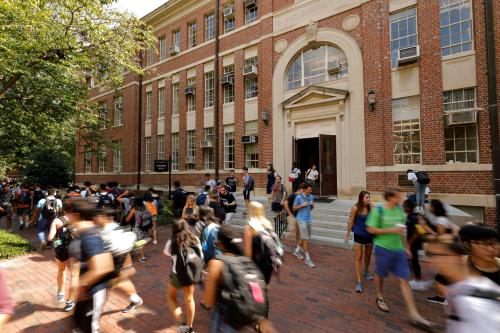One year ago, I wrote on these pages: “If new border controls prevent the entry of foreign students, or simply makes them feel unwelcome so they go elsewhere, American jobs and American students pay the price.” I regret to report that we have now started down that path.
First, the fact: College enrollment of international students is down for the first time in a long time. The drop is large, but not overwhelming—at least not yet. We’ve seen a one-year decrease of about 30,000 students, which isn’t massive. However, Department of Education data suggests that foreign-student enrollment had risen consistently for the last 35 years. Here’s a picture based on NSF data. (A nice article in Inside Higher Ed gives more details.)
In the short run, losing international students is bad for what some might think of as a pretty crass reason: International students subsidize American kids because nonresidents pay higher tuition and receive less financial aid. This is especially true at public universities. For example, at the University of California—which is the world’s largest research university system—Californians pay about $14,000 in tuition and fees. International students pay more like $41,000—that’s roughly triple. And about a third of tuition is turned around and spent on financial aid, but almost none of that goes to international students. So the effective price difference is even bigger than list price would indicate.
The immediate effect of losing foreign students falls very unevenly across institutions. Unsurprisingly, international enrollments continue to climb at some universities (typically elite or flagship public universities), while international enrollments plummet at others (typically smaller, less prestigious institutions). The resulting budget cuts at the latter often hit in the areas that are already under the most financial stress, not necessarily the areas which attract the most international students. The New York Times writes, “At Wright State University in Ohio, the French horn and tuba professors are out. … At Kansas State, Italian classes are going the way of the Roman Empire.”
The immediate budget impact is bad, but I worry also about a longer-run, more serious problem. Bringing international students to the United States has two valuable way-down-the-road outcomes. One easy-to-see benefit is that we get to cream skim, keeping some of the best students in the United States. Just as an example, many tech-entrepreneurs came to the U.S. this way. Losing international students will harm the domestic economy in the long run.
A harder-to-see benefit is that many international students who return home do so with an appreciation for what America is really like. I believe that to know us is to love us. And it’s not just a matter of affection; surprisingly large numbers of foreign government officials have American degrees. Just as an economics example, the governors of the central banks of Europe, England, Israel, Argentina, India, and Mexico all have American degrees. Though the governors of the central banks of China and Russia don’t have American degrees, each did spend a year studying at an American university. Though the benefits from these educational exports are difficult to quantify, presumably some diplomatic goodwill in foreign governments across the globe is a result.
International college students bring us economic benefits today and political benefits in the future. I really hope that, a year from now, I’m not sharing with you that things have gotten worse.
The Brookings Institution is committed to quality, independence, and impact.
We are supported by a diverse array of funders. In line with our values and policies, each Brookings publication represents the sole views of its author(s).






